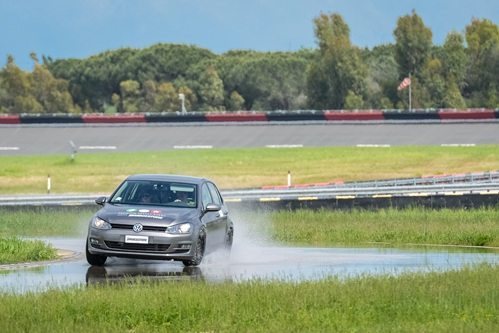Bridgestone encourages journalists to spread the premium tyre message
 Wet circuit tests highlighted several performance gaps between the Bridgestone and imported tyres
Wet circuit tests highlighted several performance gaps between the Bridgestone and imported tyres
The motoring public, states Bridgestone, has “a low understanding of tyres and little affinity with them,” and in many cases consider a tyre to be a round and black commodity typically acquired as a distress purchase. This point of view is unlikely to change unless drivers are more regularly exposed to tyre-related information, and therefore Bridgestone is currently striving to influence the people that may possibly influence you.
At present most information about tyres is given by those who sell them; Bridgestone estimates that around 80 per cent of motorists seek purchase advice from tyre or car dealers when buying tyres. But while Bridgestone’s own market information (gleaned from a 2015 survey of 6,000 respondents in six markets) names “safety and control in wet conditions” and, more specifically, “short stopping distance on a wet surface” as the most important tyre need amongst motorists, European and UK sales statistics show that this stated safety priority isn’t actually reflected in tyre sales. Most consumer tyre purchases are cost-driven, and given this contradiction between what motorists say and what they buy, Bridgestone has launched a three-pronged motorist education programme in Europe.
Through this programme, Bridgestone aims to educate motorists about the importance of tyres and their proper maintenance, and in particular get across the message that premium tyres provide safety and performance benefits that can’t be guaranteed by lower cost imported products. In addition to spreading this position via a pan-EU advertising campaign that was launched in October 2014 and through a programme of free tyre safety checks in public places such as car parks and shopping centres, Bridgestone is holding specific media events, such as its ‘Premium Safety workshop’, that aim to provide journalists with first-hand experience about the safety benefits of fitting premium tyres.
While Tyres & Accessories hasn’t taken part in a Bridgestone Premium Safety workshop – the phrase ‘preaching to the choir’ springs to mind – the manufacturer’s desire to get media representatives onside is certainly understandable. A recent media education event took place at the Bridgestone European Proving Ground in Aprilia, Italy at the end of April; the tyre maker invited more than 60 journalists from seven European countries to participate in a number of workshops that compared the merits of Bridgestone and “low-cost” imported tyres.
The event’s core workshops were held on the proving ground’s ‘black lake’ wet surface track and compared Bridgestone Turanza T001 tyres with an unnamed imported tyre brand. Sets of both tyres were fitted to VW Golf VII 2.0 TDIs, and the invited journalists were encouraged to experience the difference in wet cornering and hydroplaning between the two tyre brands. A V-Box measuring system in the car then measured actual stopping distances in a wet braking test, and Bridgestone made certain that its guests were absolutely clear about the results.
The car fitted with Turanza T001 tyres stopped an average of four metres before the Golf fitted with the imports, and when the Bridgestone-shod car came to a stop the other vehicle was still travelling at a minimum of around 22km/h (13.7mph) – a high enough speed to cause material damage and physical injury. According to a Department for Transport OTS study published in 2010, an impact with a pedestrian at 22km/h can cause light to serious injuries, mainly to the head and legs, in 40 per cent of cases. And a head-to-tail accident at speeds lower than this will typically cause headlamp and panel damage, and most likely activate at least one of the car’s airbags.
The bottom line that Bridgestone aimed for journalists to take away is that the initial price saving of around £90 gained through spurning premium tyres in favour of a set of budget imported tyres could compromise personal safety and become very expensive in the long run. The company estimates the material damage resulting from an accident such as the one mentioned above to be around £3,000.
Why spread the ‘premium’ message?
Bridgestone’s advertising campaign and media education efforts are taking place at a critical time. Imported budget passenger car tyres have nibbled at premium manufacturers’ market share in Europe for a number of years and all but destroyed the middle tier players; imports of Chinese tyres into Europe almost doubled between 2007 and 2013 and represented 45 per cent of all European tyre imports in 2013. Earlier this year, Bridgestone Corporation reported that its own sales of passenger car and light commercial vehicle tyres in Europe decreased year-on-year in 2014.
And as tyrepress.com noted in its editorial commentary ‘Consolidation now’ last week, US import tariffs on consumer tyres produced in China are pushing volumes to Europe, especially southern Europe and the UK, which means companies such as Bridgestone have all the more reason to be uneasy about a motoring public that is under-informed and buys on price.


Comments